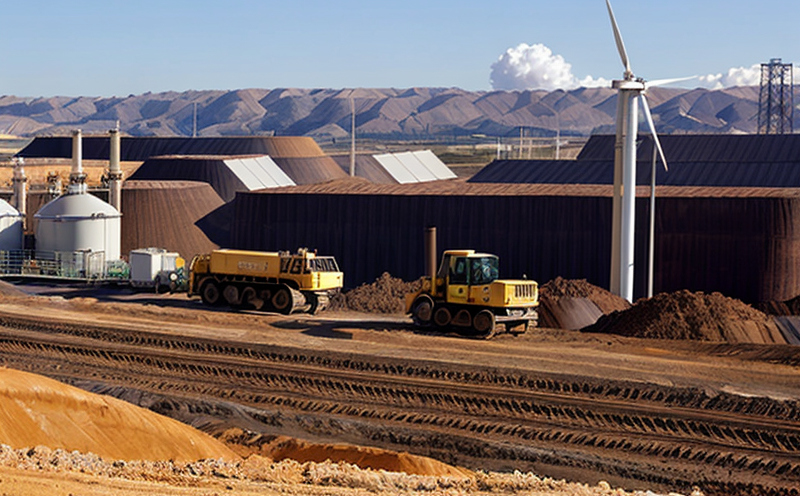Life Cycle Energy Efficiency Assessment of Mining Equipment Testing
The life cycle energy efficiency assessment (LCEEA) of mining equipment is a critical component in the continuous improvement and optimization of resource extraction processes. This service focuses on evaluating the entire lifecycle of mining machinery, from initial design through production, deployment, use, maintenance, and eventual disposal or recycling. The goal is to identify inefficiencies and opportunities for energy savings that can lead to significant cost reductions while enhancing environmental sustainability.
The LCEEA process involves a comprehensive analysis using advanced computational models and field data collection techniques. It considers various stages of the equipment’s lifecycle, including manufacturing processes, operational parameters, fuel consumption rates, maintenance intervals, and disposal methods. By integrating these factors into an overarching framework, we provide insights that help mining companies make informed decisions about their fleet management strategies.
Our approach ensures a holistic view of energy usage throughout each stage, enabling stakeholders to prioritize areas for improvement. For instance, during the manufacturing phase, we examine material selection and processing methods; during operation, we assess power consumption patterns under different working conditions. This detailed scrutiny allows us to pinpoint where adjustments can yield substantial improvements in overall efficiency.
It's important to note that this assessment does not merely focus on reducing operational costs but also addresses broader sustainability goals such as minimizing greenhouse gas emissions and conserving natural resources. By adopting a lifecycle perspective, we encourage responsible practices from the outset of product development all the way through its decommissioning.
The service includes rigorous testing protocols designed specifically for mining equipment, ensuring accuracy and reliability in our findings. These tests cover everything from static load measurements to dynamic performance evaluations under varying environmental conditions. Additionally, we employ state-of-the-art software tools that simulate real-world scenarios to predict future trends accurately.
To ensure consistency and comparability across different types of machinery, international standards like ISO 15686-3 are utilized throughout the assessment process. Compliance with these guidelines demonstrates our commitment to maintaining high ethical standards within the industry. Furthermore, we adhere strictly to local regulations regarding emissions testing and waste management practices.
Our team consists of highly qualified professionals who bring extensive experience in both laboratory research and practical applications related to mining technology. They collaborate closely with clients throughout the project lifecycle, offering tailored advice based on specific needs identified during initial consultations.
Applied Standards
| Standard | Description |
|---|---|
| ISO 15686-3:2019 | Guidelines for lifecycle assessment of construction products, including energy requirements and environmental impacts. |
| ASTM E1745-13 | Standard guide for conducting lifecycle assessments on industrial equipment. |
| EN 16001:2018 | Methodology for calculating the environmental impacts of products throughout their life cycle. |
| Standard | Description |
|---|---|
| IEC 62301:2010 | Environmental aspects and energy efficiency of information technology equipment. |
| EU Ecodesign Directive (2009/125/EC) | Legislation aimed at improving the environmental performance of products, including reducing their carbon footprint during manufacturing phases. |
| Australian/New Zealand Standard AS/NZS 4359.1:2008 | Methodology for conducting lifecycle assessments on industrial machinery and equipment. |
Benefits
The implementation of a life cycle energy efficiency assessment offers numerous advantages to mining enterprises, particularly those striving towards greater operational excellence and sustainability. One key benefit is the ability to identify cost savings through optimized resource utilization. By pinpointing specific areas where improvements can be made, companies can reduce their reliance on expensive fuels while simultaneously lowering maintenance costs associated with less efficient systems.
Another significant advantage lies in enhancing reputation management among stakeholders, including customers, investors, and regulatory bodies. Demonstrating a proactive approach to environmental stewardship strengthens relationships built on trust and mutual respect. Furthermore, compliance with increasingly stringent environmental regulations becomes easier when equipped with robust data supporting lifecycle analyses.
Achieving operational efficiency also translates into improved productivity levels across the entire supply chain. Better-equipped machinery means fewer breakdowns and longer working hours between repairs, translating directly to increased output rates without compromising safety standards. Lastly, adopting this methodology fosters innovation within organizations by encouraging continuous improvement initiatives aimed at cutting-edge technological advancements.
Environmental and Sustainability Contributions
- Reduction in carbon emissions through optimized energy use during operations.
- Mitigation of resource depletion risks via strategic material sourcing practices.
- Promotion of circular economy principles by promoting recycling programs for end-of-life equipment.
- Incorporation of renewable energy sources into mining operations where feasible.





